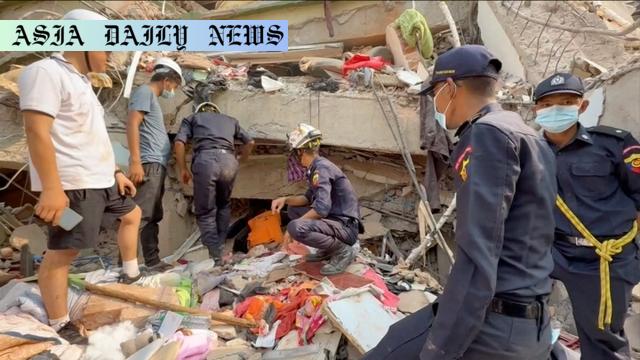Myanmar earthquake: Rescue efforts continue as death toll reaches 1,700.
The Myanmar earthquake of 7.7 magnitude has claimed 1,700 lives and injured 3,400 people.
Rescue operations face challenges due to ongoing tremors and political instability.
Neighboring Thailand also faced devastation with structural collapses and casualties.
International support and cooperation from local authorities are underway to assist the victims.

Massive Earthquake Hits Central Myanmar
On Friday, Myanmar was struck by a devastating 7.7-magnitude earthquake centered in the central region of the country. As of now, the tragic event has claimed approximately 1,700 lives and left over 3,400 individuals injured. Rescue teams have been deployed across affected areas to search for survivors, though the ongoing aftershocks have significantly hampered their efforts. From the country’s bustling capital Naypyitaw to smaller towns in the northern Sagaing region, the scenes of destruction have alarmed residents and authorities alike. Buildings have crumbled, infrastructure is heavily damaged, and countless families have been displaced.
Chaos in Naypyitaw
Naypyitaw, Myanmar’s capital, bore significant damage from the earthquake. A retail facility housing multiple retail outlets collapsed, leading to the tragic death of two employees working in a mobile phone store. Survivors recounted fleeing the crumbling structure in panic as chaos unfolded around them. Emergency workers remain on-site, attempting to recover both the surviving and deceased trapped under the rubble. Citizens in the capital reflect the harrowing reality of attempting to piece together their lives amidst aftershocks and crumbled structures.
Fighting Suspended for Relief Efforts
The political climate in Myanmar adds another layer of complexity to the disaster response. Ever since the military orchestrated a coup in 2021, clashes between the regime and pro-democracy forces have plagued the region. However, the National Unity Government (NUG) recently issued a historic statement pledging to suspend fighting in disaster-affected regions for two weeks. This truce aims to prioritize rescue operations and the delivery of humanitarian aid to trapped civilians. The NUG has also opened doors for collaboration with international organizations to expedite relief distribution efforts.
Impact on Religious and Cultural Heritage
The northern Sagaing region, near the earthquake’s epicenter, suffered extensively. Reports indicate that three of five mosques in one community were reduced to ruins. As residents painstakingly sift through debris in search of survivors, the broader destruction to historical and religious sites symbolizes the far-reaching impact of the disaster. Community members in this region count not just the human toll but also grapple with the loss of heritage and security that these sites represent. Around 200 persons in Sagaing are feared dead or missing, adding to the mounting toll from the earthquake.
Thailand Faces Aftershock Consequences
The earthquake’s devastation was not confined to Myanmar alone. Neighboring Thailand experienced secondary impacts, highlighting the transnational influence of the tremors. In Bangkok, a high-rise building under construction collapsed, claiming at least nine lives and leaving over 70 individuals unaccounted for. Thai authorities have initiated large-scale search and rescue operations to locate missing persons. The quake serves as a sharp reminder of how a single natural disaster can ripple across borders, leaving devastation in its wake.
International and Local Support
In the aftermath of the earthquake, international organizations and local entities have mobilized efforts to provide aid. Japan, which experienced the loss of one of its nationals in the disaster, has pledged to aid Myanmar’s rescue mission. Other nations and humanitarian organizations are following suit, reflecting a commitment to pooling resources in times of crisis. Despite these measures, sustained international collaboration, funding, and on-ground execution will be essential to recover from the tragedy fully.
Challenges Ahead
While efforts to recover and rebuild are underway, significant challenges remain. Myanmar’s political instability compounds the difficulty of disaster relief, as certain affected areas are conflict zones. Continued tremors, destruction of infrastructure, and logistical challenges further complicate the rescue work. Nevertheless, the resilience of the people and their ability to resist despair underlines the human spirit’s capacity to adapt and overcome even the most devastating circumstances.
Commentary
Reflection on the Human Toll of Natural Disasters
Natural disasters serve as stark reminders of human vulnerability in the face of nature’s wrath. The tragedy unfolding in Myanmar is heartbreaking, with thousands of lives lost or irrevocably altered in the wake of the 7.7-magnitude earthquake. Beyond the numbers, each statistic represents a story—a loved one lost, a family displaced, and a community left grappling with unimaginable grief. Reflecting on this disaster calls for a stronger push to prepare for such emergencies, especially in regions susceptible to earthquakes and other natural calamities.
The Intersection of Politics and Disaster Preparedness
Myanmar’s case uniquely highlights how political instability amplifies the effects of natural disasters. Ongoing conflicts, lack of streamlined responses, and potentially limited resource allocation due to political priorities paint a grim picture. It is a somber reminder for governments worldwide—political cohesion and proactive suppression of tensions lay the groundwork for stronger disaster resilience. In times of nature’s fury, human-induced turbulence leaves nations far more vulnerable than they ought to be.
Global Responsibility Amid Climate Catastrophes
The Myanmar earthquake likewise serves as a call to extend international support not just through short-term aid, but via cooperative measures aimed at strengthening disaster preparedness worldwide. Rich nations and neighboring countries bear a collective responsibility to help earthquake-prone regions develop infrastructure that can withstand such forces. Investing in disaster education, robust urban planning, and technological solutions can help mitigate human losses.
Hope Amid Destruction
Amid the devastation, glimpses of humanity’s unyielding spirit offer hope. From rescuers risking their lives for survivors to citizens prioritizing their community’s safety over personal loss, these acts inspire us to persevere. Natural disasters may test our resilience, but they also bring to light our shared humanity and capacity to rebuild lives and societies stronger than before. Myanmar and its people will undoubtedly display this courage and resilience in the months and years ahead as they recover from this tragedy.


